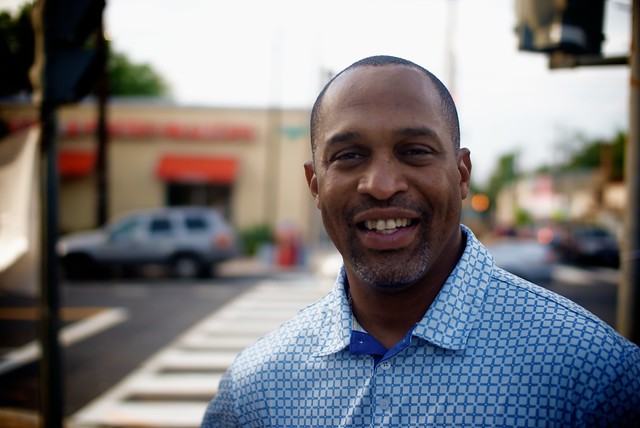 |
| Councilmember Thomas. Photo by mediaslave on Flickr. |
With part of Thomas' new duties including oversight of the Department of Small and Local Business Development (DSLBD), one might expect him to focus on revitalizing the city's struggling commercial corridors. Instead, we have a Councilmember who has often championed more of the status quo.
In his November 15 testimony before the DC Zoning Commission on proposed car and bike parking regulations in the zoning code, Thomas said,
"I have recently spoken with representatives of several retailers who are interested in developing large, multi-tenant shopping centers in the District.... There are ... a number of locations in Ward 5 and other outlying Wards with blocks of land large enough to accommodate these developments, but without convenient access to Metrorail. Placing a cap on parking citywide, in a one-size-fits-all approach, would limit the desirability of these locations and have an adverse economic impact on the District."
We now know that Thomas was alluding to Dakota Crossing, with a planned 3,000 surface parking spaces, as well as the still developing plans for four Walmarts.
At the same time, Thomas knows very well what progressive urban infill looks like, and has helped usher it in during his tenure in Ward 5. Rhode Island Station, The Flats at Atlas District, and developments near Catholic University build on a multi- and mixed-use platform with retail space for small, local businesses.
While we continue to hear Thomas' lip service about the jobs and tax revenues that will be brought by new big boxes, our main streets continue to flounder. The Rhode Island Avenue Great Streets Initiative, for example, seems to have fallen off of DMPED's radar.
Can Thomas, who will have oversight of DMPED as Chair of the Committee on Economic Development, push for movement on a plan that could link the District's side of this important gateway with the revitalization that is happening just across the border in Mt. Rainier and Hyattsville?
While Brookland's 12th Street NE commercial strip received streetscape improvements, it still struggles to attract new businesses. North Capitol Main Street, Inc. continues to make strides in promoting local businesses, but will it find itself competing against a suffocating surge in big box, large-scale infill?
Will economic development East of the River under Thomas be focused on a blend of large- and small-scale development, or will bigger continue to be touted as better?
Thomas has proven an ability to work with developers and corporations on large projects. He knows the language of urban design and of Main Street commercial revitalization.
Unfortunately, a disconnect appears to exist between Thomas' advocacy for the bigger players and the smaller operators necessary to foster vital, dense cores in our neighborhoods. As he leads the Committee on Economic Development for the next four years, his actions will speak louder than words, particularly as we work our way out of the current recession.
Without a balance of both local and national retail outlets, small- and large-scale development, we will continue to see big box nodes favored to the detriment of our underutilized retail corridors, and we simply cannot afford that.
Cross-posted at Greater Greater Washington.




